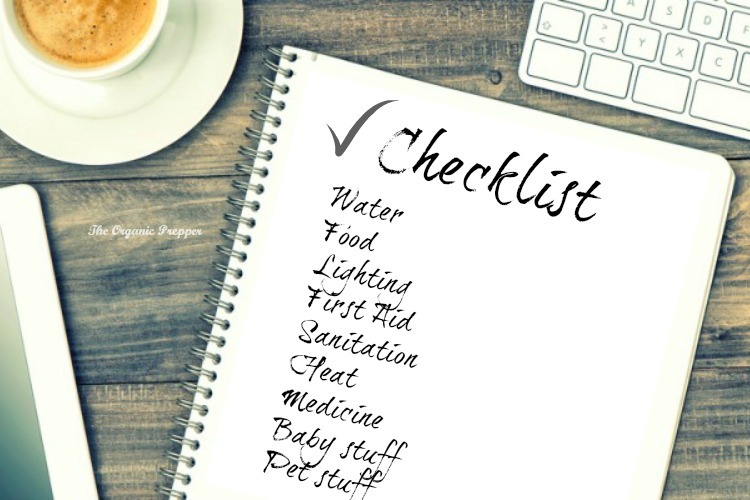If you're new here, you may want to subscribe to my RSS feed. Thanks for visiting!
Here it is, the easiest checklist you’ll ever find for getting prepped. Clearly, most of us can’t buy ALL of these supplies at the same time, so I’ve put them in order from free to top quality.
Water
- Fill every empty container in your house.
- Get some filled 1-gallon jugs at the grocery store.
- Get a travel water filter. I like this one.
- Get some large containers you can stack, like these
- Get a good quality gravity fed water filter.
- Get a manual pump for your well.
Food
- Start by seeing what you already have that doesn’t require refrigeration or cooking.
- Get a method to cook indoors during a power outage. My favorite is this inexpensive stove. Don’t forget the extra fuel.
- Get a one-week supply of inexpensive canned goods that you can heat and eat. (Soup, chicken, tuna, veggies, and fruit)
- Add buckets of freeze-dried food until you have enough to last each family member for one month. (Most freeze-dried foods are good for 25 years.)
Heat
- If you have a fireplace or woodstove, you already have a power-outage heating method. Be sure you have plenty of firewood.
- Set up one room that you can stay in if the power goes out. The room should have a door and you should be able to hang blankets at the window to insulate it.
- Invest in a Mr. Buddy propane heater. It is one of the few that is safe to be used indoors. If you also pick up the adapter, you can attach it to a larger propane canister, which is more cost-efficient.
- A battery-operated carbon monoxide alarm provides an extra measure of safety when using secondary heating methods.
Sanitation
- Stock up on baby wipes for hand-washing after using the bathroom, before and after food prep, and before eating.
- Grab some hand sanitizer. Even if you don’t normally use it, an emergency situation is an exception.
- Get bleach wipes for wiping down surfaces.
- During a short-term emergency, we use disposables: paper towels, napkins, and paper plates.
- Stock up on kitty litter. This soaks up messes and helps to absorb odor. If your toilet won’t flush because you’re on a city sewer system, it can also be used as a makeshift toilet. This serious concern is discussed here.
Light
- Go cheap with garden stake solar lights. Put them outside during the day and bring them in at night.
- Grab some long-burning candles and tealights. Store matches or lighters nearby.
- Stash flashlights around the house. (Don’t forget batteries!)
- Grab some inexpensive headlamps. These are great when you need light but you also need your hands free.
- Grab a solar light that doubles as a USB charger for your phone or other devices.
- Really power up with a 1100 watt solar generator.
First Aid
- Your kit should include basic wound care items like bandages, antibiotic ointments, tourniquets, and sprays.
- Keep on hand a supply of basic over-the-counter medications, like pain relief capsules, cold medicine, cough syrup, anti-nausea pills, and allergy medication.
- Keep a first aid manual on hand.
- Be sure to have a couple of good medical guides on hand. I like Prepper’s Natural Medicine and The Survival Medicine Handbook.
Special Needs
This is something that will be unique to every family. Here are a few things to get your wheels turning.
- Prescription medications
- Diapers and baby supplies
- Comfort items or special foods
- Pet foods and supplies
And this is only the beginning!
As you continue along your preparedness journey, you’ll find that there are other items that are very important to you. But don’t panic. Remember that Rome wasn’t built in a day and neither are fully prepped households!
Go here to get a printable version of this list.















